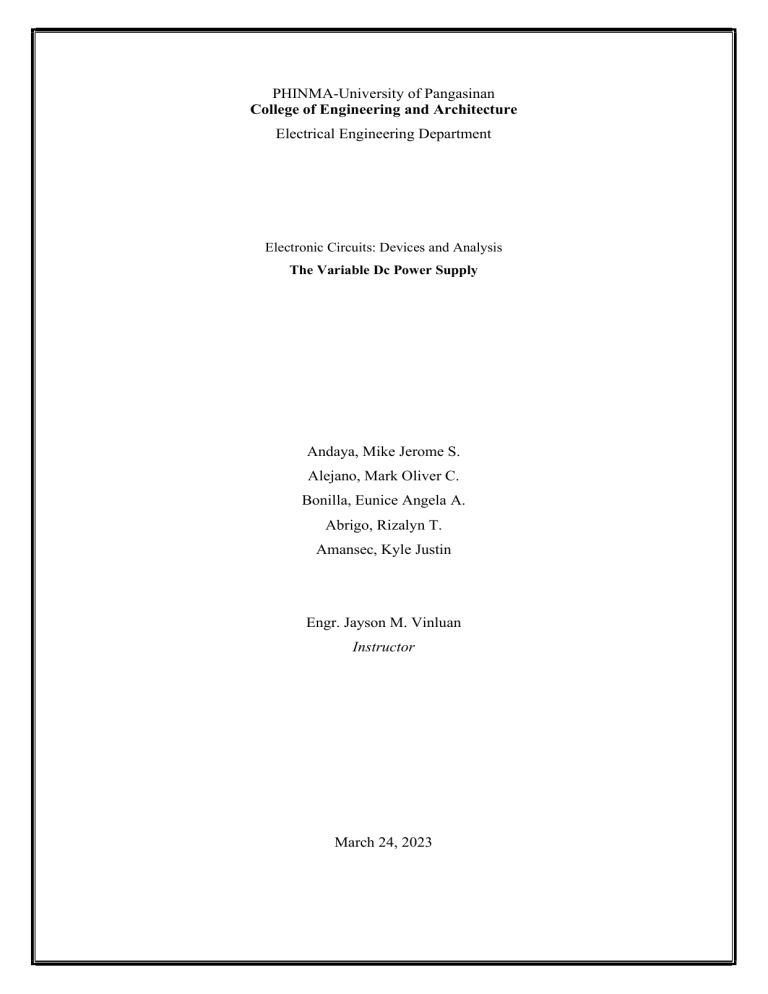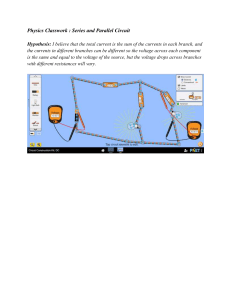
PHINMA-University of Pangasinan College of Engineering and Architecture Electrical Engineering Department Electronic Circuits: Devices and Analysis The Variable Dc Power Supply Andaya, Mike Jerome S. Alejano, Mark Oliver C. Bonilla, Eunice Angela A. Abrigo, Rizalyn T. Amansec, Kyle Justin Engr. Jayson M. Vinluan Instructor March 24, 2023 Laboratory Report No.01 The Variable DC Power Supply TABLE OF CONTENTS I. Objectives II. Introduction III. Equipment and Circuit Component IV. Set-Up/Schematic Drawings i. Figure 1.1 ii. Figure 1.2 iii. Figure 1.3 iv. Figure 1.4 V. Data and Results VI. Analysis and Discussion VII. Conclusion VIII. Appendix IX. References Page 1 of 19 Laboratory Report No.01 The Variable DC Power Supply I. Objectives The purpose of this paper is to guide readers to a process of designing, structure and testing of a DC power supply for an introductory engineering course. All the factors of the circuit are explained along with the design approaches and computations. II. Introduction This document provides an overview of the introductory design and operation behind a nearly universal in the world, a power supply. The power supply can simply comprise four particular electronic factors the motor, the rectifier, the filter, and the voltage regulator. While the first three factors are responsible for stepping down the AC voltage, converting AC voltage to DC voltage, and maintaining the ripple of DC voltage in a asked range; the voltage controller can play an important part in furnishing a constant DC affair voltage, which isn't affected by changes in the cargo currents, the input voltage or the temperature. Electronic devices or circuits are highly sensitive. An excessive flow of 220 volts of electricity or alternating current (AC) could harm the circuitry, whereas a steady direct current (DC) at a low voltage is harmless to the electronic components. Page 2 of 19 Laboratory Report No.01 The Variable DC Power Supply III. Equipment and Circuit Component A. Equipments Breadboard Soldering lead/iron Cutter/ Scissor Pliers Driller Enclose Box/ Case Ferric Chloride (Pure) Angle Grinder B. Circuit Components T1 - 12.6 Volt Center tapped transformer D1-D4 - 1N4001 Rectifier Diode C1 - 1000 microfarad 25 volt Capacitor C2-C3 - 0.1 microfarad 200 volt Ceramic Capacitor R1 - 510 ohm, ± 5%, 0.5 watt R2 - 680 ohm, ± 5%, 0.5 watt 5 k ohm trimpot, 10 turn ± 5%, 0.5 watt Red Standard Emitting Diode (LED) U1 - LM317T Voltage Regulator Heat Sink Jumper Wires C. Components of the Power Supply Printed Circuit Board Plug Rocker Switch Fasteners (bolts, screws) Page 3 of 19 Laboratory Report No.01 The Variable DC Power Supply IV. Set-Up/Schematic Drawings ' Figure 1.1 [DC Power Supply Schematic] Figure 1.1 is the circuit diagram used for the construction of the power supply. Analysis of the different stages that make up a power supply, makes one understand the device. Therefore, a transformer is utilized to decrease the AC input to the required value and provide the necessary AC voltage value. To convert an AC signal to a DC signal, a rectifier is employed. At the load end connection, the rectifier transforms the alternating current supply to direct current. There are several kinds of rectifiers, including half-wave, full-wave, and bridge rectifiers. A full bridge rectifier is made up of four diodes coupled in the shape of a bridge. At forward bias, the diode only conducts in one direction. In the opposite direction, i.e. during reverse bias, it remains in an off state. However, the output from the rectifier is not a pure DC output, but rather contains numerous ripples, making it highly uneven. To smooth out the DC output and eliminate the AC content of the rectifier, a filter circuit is implemented. This filter can be either an inductor-capacitor filter or a resistive-capacitive filter, depending on the specified circuit design and the type of power supply. The output now becomes a complete DC signal with constant voltage, but it is still unregulated voltage, meaning that the design is receiving a voltage higher than necessary. To obtain a variable or a constant output of 5, 12, or 24V, a voltage regulator is employed. This power supply provides a variable or constant voltage output at a constant current or an independent current output. Page 4 of 19 Laboratory Report No.01 The Variable DC Power Supply Figure 1.2 [Hardwired implementation in the Breadboard of DC Power Supply] A bread board is employed to construct provisional circuits. It proves advantageous to developers as it facilitates the effortless removal and replacement of components. The prototype area is located in the center of the breadboard. This region is made up of 5 hole rows that are joined together. Between the two sets of rows, there is a channel for putting chips with pins on both sides, which prevents pins from being joined together. There are also power busses (typically one or two) along the breadboard's sides for running power and ground throughout the board. Page 5 of 19 Laboratory Report No.01 The Variable DC Power Supply Figure 1.3 [ DC Power Supply PCB Artwork] Figure 1.4 DC Power Supply PCB Artwork 3D Page 6 of 19 Laboratory Report No.01 The Variable DC Power Supply The relationship may seem somewhat altered following the transfer of the elements from the breadboard to the power circuit board (PCB), but it remains unchanged. The PCB includes an input terminal for the transformer connection. Next, the four diodes were linked with the capacitor in accordance with their polarity. The positive connection of the filter capacitors is subsequently joined to the voltage regulator's input connector. The voltage regulator's adjustable connection is connected to the potentiometer to modify the voltage input. The voltage regulator's output is attached to the positive side of the third ceramic capacitor. The LED is then connected after the resistor to safeguard it from harm. To conclude, there are the output terminals where the output voltage can be measured. Page 7 of 19 Laboratory Report No.01 The Variable DC Power Supply V. Data and Results 1. Output Voltage and LED Test: LED operational YES (As voltage increases, the brightness also increases) Output Voltage Range of Adjustment 2.08 V to 14.5 V 2. Adjust output to 5 VDC with 20 ohm load resistor attached to the output Calculated Load Current 0.25 A Measured Load Current 0.25 A Calculate the power being dissipated by the 20 ohm resistor? 1.25 Watts 3. Calculate the expected turns ratio of the transformer from the transformer data listed on the Bill of Material. Calculate and measure VsecRMS. Calculated n = 18.33 turns Measured Vrpp RMS = 236 V 4. Calculate the expected DC Voltage (VDC) and Peak to Peak Ripple (Vrpp) out of the filter circuit using the formula: Vrpp = ILoad/fc where f = frequency and C is the value of the filter capacitor. Use a load current of 70 milliamps. Calculated VDC = 16.82 V 5. Calculated Vrpp = 0.583 V Measure the DC Voltage (VDC) and Peak to Peak Ripple (Vrpp) out of the filter circuit values with the 20 ohm resistor in place: Measured VDC = 16.82 V 6. Calculated Vsec RMS = 12 V Measured Vsec RMS = 13.30 V Measured Vrpp = 0.583 V Measure VDC and Vrpp of the output voltage of the power supply with the 20 ohm load resistor in place. VDC of the Power Supply Output = 5 V Vrpp of the Power Supply Output = 0 V Page 8 of 19 Laboratory Report No.01 The Variable DC Power Supply Computations for Part V: 2. Calculated Load Current Power dissipated I= P = VI I= P = (5)(0.25) I = 0.25 A P = 1.25 W 3. Calculated n 𝑁𝑝𝑟𝑖 𝑉𝑝𝑟𝑖 = 𝑁𝑠𝑒𝑐 𝑉𝑠𝑒𝑐 𝑁𝑝𝑟𝑖 220 = 1 12 N = 18.33 turns ≈ 18 turns 4. Calculated VDC Calculated Vrpp Vsec = 13.30 Vrms Vrpp = Vm = (13.30)(√2) = 18.81 V Vrpp = Vdc = Vrpp = 583.33 mV Vdc = ( . ( )( ) ) Vdc = 11.97 V ≈ 𝟏𝟐 𝑽 Page 9 of 19 Laboratory Report No.01 The Variable DC Power Supply VI. Analysis and Discussion VII. Conclusion A variable direct current (DC) power supply is an electronic circuit that converts aternating voltage (AC) to direct voltage (DC). The circuit is housed in a case or protective enclosure. An example use of a power source is a backup power source, such as a battery. The group learns that the main purpose of the power supply is delivery of the voltage required for operation. It is also useful for students if the course is designed using DC machines and electronics for labs and experiments. The group also learned to use a diode acting as a rectifier to convert an alternating current (AC) voltage that fluctuates in two directions into a type of direct current (DC) voltage that pulsates in one direction. A filter that adjusts the voltage to smooth the pulse and a voltage regulator that adjusts the voltage to remove ripple. While conducting the laboratory activity, the group observed that the overall expected output was not accurate, but the output voltage was close to the target output using simulations and real experiments. tested various output voltages, and when the group switched to other outlets, the group concluded that the current in the various outlets changed the resulting output voltage. After conducting all the experiments, the team collected data and information on the output voltage. And comparing the results obtained, the team concluded that the output voltage of the power supply that produced the expected output voltage was solved by applying theories and formulas. After working in the laboratory activity, the group managed to get the right amount of output voltage with only a slight margin of error, which is the effect of tolerances in the resistor. Therefore, the group concluded that this power source is reliable and can be used for other projects and lab experiments in the future. Since this project involves a voltage regulated output power supply, many improvements are possible. First, build the power supply to get more output voltage than the band experience. Secondly, this type of power supply can add an extra feature of converting 220V to 110V, which is very useful for devices requiring low Page 10 of Laboratory Report No.01 The Variable DC Power Supply voltage. Third, add more light-emitting diodes (LEDs) to the power supply as an indicator of the output voltage. For application, this type of power supply can be used in many ways as a charger, batteries and as a reference to other research to discover new high-tech tunable power supplies. Page 11 of Laboratory Report No.01 The Variable DC Power Supply VIII. Appendix ' Figure 1.1 [DC Power Supply Schematic] Figure 1.2 [Hardwired implementation in the Breadboard of DC Power Supply] Page 12 of Laboratory Report No.01 The Variable DC Power Supply Figure 1.3 [ DC Power Supply PCB Artwork] Figure 1.4 DC Power Supply PCB Artwork 3D Page 13 of Laboratory Report No.01 The Variable DC Power Supply Initial breadboard simulation Testing the PCB Page 14 of Laboratory Report No.01 The Variable DC Power Supply Sketch of the PCB Measuring the voltage output Page 15 of Laboratory Report No.01 The Variable DC Power Supply Building the casing of the Power Supply Page 16 of Laboratory Report No.01 The Variable DC Power Supply Testing the maximum and minimum brightness of the LED Final PCB Page 17 of Laboratory Report No.01 The Variable DC Power Supply IX. References [1] Marvell-Maxim-Micrel-and-more (2011, December). Retrieved March 22,2023http://more.componentsdirect.com/blog/bid/260173/Product-EdVoltage-Regulators [2] Adjustable Voltage Regulator Retrieved from: http://www.circuitstoday.com/25-vadjustable-regulator-using-lm117-ic [3] Wavelength Electronics (2018). Power Supply Basics Retrieved March 22, 2023 from https://www.teamwavelength.com/power-supply-basics/ [4] M. H. Rashid, “Power Electronics”, 3rd ed, Burlington, MA: Elsevier Inc., 2007, pp. 600-610. [5] S. Salvivahanan, “Linear Integrated Circuits”, New Delhi: Tata McGraw-Hill, 2008, pp. 375-385 [6] ITP Physical Computing. Understanding Power Supplies (2019). Retrieved from https://itp.nyu.edu/physcomp/lessons/electronics/understanding-dc-power-supplies/ [7] How to Electronics. Pragya Chauhan (August 20, 2022) AC to DC Converters: Features, Design & Applications. Retrieved March 22, 2023 from https://how2electronics.com/ac-to-dc-converters-features-design-applications/ Page 18 of





